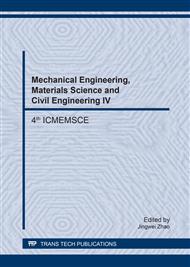[1]
P. Zhou, Y.H. Fan, P. Wang, J. Chen, The indentation thermal shock behavior of laminated ZrB2-SiC ceramics with strong interfaces, Ceram. Int. 42 (2016) 17489-17496.
DOI: 10.1016/j.ceramint.2016.08.056
Google Scholar
[2]
J. Watts, G. Hilmas, W.G. Fahrenholtz, Measurement of thermal residual stresses in ZrB2-SiC composites, J. Eur. Ceram. Soc. 31 (2011) 1811-1820.
DOI: 10.1016/j.jeurceramsoc.2011.03.024
Google Scholar
[3]
Q.L. Guo, S.J. Luo, J.Z. Gan, J.G. Li, L.M. Zhang, Effect of ball milled Zr/Al/ZrB2 composite powders on microstructure and toughening of ZrB2-SiC/Zr-Al-C composite ceramics sintered by spark plasma sintering, Mater. Sci. Eng. A 644 (2015) 96-104.
DOI: 10.1016/j.msea.2015.07.010
Google Scholar
[4]
D.X. Li, Z.H. Yang, D.C. Jia, C. Hu, B. Liang, Y. Zhou, Preparation, microstructures, mechanical properties and oxidation resistance of SiBCN/ZrB2-ZrN ceramics by reactive hot pressing, J. Eur. Ceram. Soc. 35 (2015) 4399-4410.
DOI: 10.1016/j.jeurceramsoc.2015.08.010
Google Scholar
[5]
Y.H. Huang, D.L. Jiang, J.X. Zhang, Sintering kinetics of YAG ceramics, J. Rare Earth 32(2014) 416-422.
Google Scholar
[6]
M.H. Xu, J.G. Song, D.M. Du, F. Wang, The Mechanism of Controlling Pore Microstructure for YAG Porous Ceramics, Key Eng. Mater. 680 (2016) 216-219.
DOI: 10.4028/www.scientific.net/kem.680.216
Google Scholar
[7]
R.R. Wang, Y.C. Wang, Z.Y. Fu, Phase evolution of YAG powders obtained by gel combustion combined with field-assisted rapid synthesis technique, Ceram. Int. 41(2015) 7289-7295.
DOI: 10.1016/j.ceramint.2015.02.009
Google Scholar
[8]
S.A. Kumar, J. Senthilselvan, Co-precipitation synthesis and spectroscopic studies of YAG and Yb: YAG nanopowder for opto-electronic applications, Trans. Indian Inst. Metal. 68 (2015) 153-159.
DOI: 10.1007/s12666-015-0539-3
Google Scholar
[9]
J.G. Song, D.M. Du, F. Wang, M.H. Xu, Synthesis Mechanism of ZrB2@A12O3-Y2O3 Composite Powders with Core-shell Microstructure, Key Eng. Mater. 680 (2016) 133-136.
Google Scholar
[10]
N. Joshi, K. Rawat, R.K. Pujala, Ionic liquid induced surface exclusion and anomalous first-order phase transition in Laponite dispersions, J. Molecul. Liquid. 207(2015) 177-184.
DOI: 10.1016/j.molliq.2015.03.034
Google Scholar
[11]
T. Kang, I. Jang, S.G. Oh, Surface modification of silica nanoparticles using phenyl trimethoxy silane and their dispersion stability in N-methyl-2-pyrrolidone, Colloid. Surf. A. 501 (2016) 24-31.
DOI: 10.1016/j.colsurfa.2016.04.060
Google Scholar


